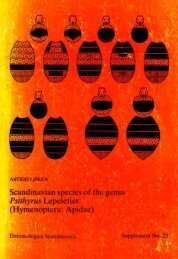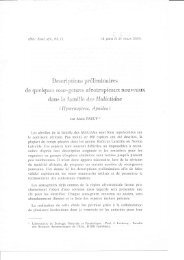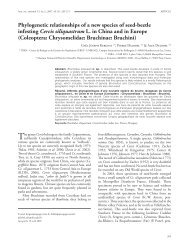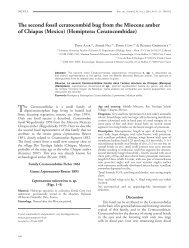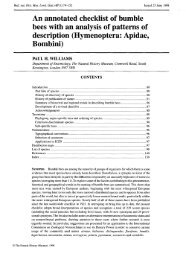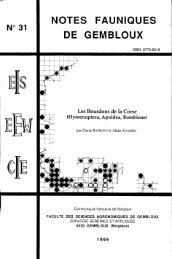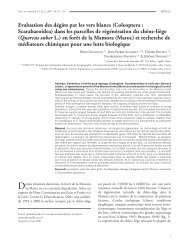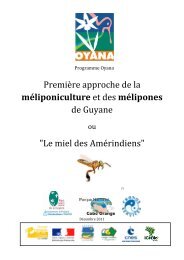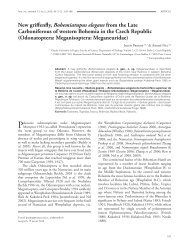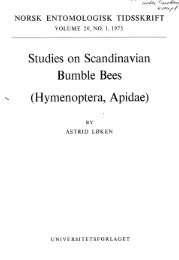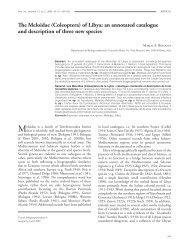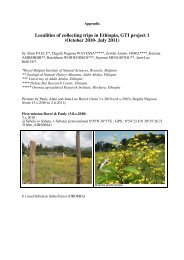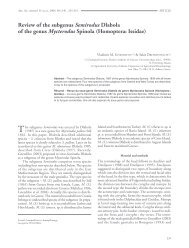Préférence des reines vierges de Bombus terrestris - Laboratoire de ...
Préférence des reines vierges de Bombus terrestris - Laboratoire de ...
Préférence des reines vierges de Bombus terrestris - Laboratoire de ...
Create successful ePaper yourself
Turn your PDF publications into a flip-book with our unique Google optimized e-Paper software.
T. Mathy – <strong>Préférence</strong> intraspécifique <strong><strong>de</strong>s</strong> <strong>reines</strong> <strong>de</strong> <strong>Bombus</strong> .<strong>terrestris</strong> pour les sécrétions céphaliques – Page 68<br />
Ings T. J. Schikora & L. Chittka, 2005. Bumblebees, humble pollinators or assiduous inva<strong>de</strong>rs? A population<br />
comparison of foraging performance in <strong>Bombus</strong> <strong>terrestris</strong>. Behavioural ecology, 144: 508-516.<br />
Karlson P, 1960. Pheromones Ergebnisse <strong>de</strong>r Biologie, 22: 212‐225.<br />
Karlson P. & A. Butenandt, 1959. Pheromones (ectopheromones) in insects Annual Reviews Entomology. 4:<br />
39–58.<br />
Karlson, P. & M Lüscher, 1959. ‘Pheromones’: a New Term for a Class of Biologically active Substances.<br />
Nature, 153: 55-56.<br />
Kawakita A, T. Sota, J. Ascher, M. Ito & H. Tanaka, 2003. Evolution and phylogenetic of Alignment Gaps<br />
Within Intron sequence of Three Genes in Bumble Bees (<strong>Bombus</strong>). Molecular biology evolution, 20(1):<br />
87-92.<br />
Kawakita A, T. Sota, M. Ito, J. Ascher, H. Tanaka, M. Kato & D. Roubik, 2004. Phylogeny, historical<br />
biogeography, and character evolution in bumble bee (<strong>Bombus</strong>: Apidae) based on simultaneous analysis<br />
of trhree nuclear gene sequence. Molecular Phylogenetic and Evolution, 31: 799-804.<br />
Krieger G., M-J. Duchateau, A. Van Doorn, F. Ibarra, W. Francke & M. Ayasse, 2006. I<strong>de</strong>ntification of<br />
quenn sex pheromone components of the bumblebee <strong>Bombus</strong> <strong>terrestris</strong>. Journal of Chemical Ecology,<br />
32(2): 453-471.<br />
Krüger E.V., 1951. Über die Bahnflüge <strong>de</strong>r Männchen <strong>de</strong>r Gattungen <strong>Bombus</strong> und Psithyrus (Bombidae,<br />
Hymenoptera). Zeitschrift für Tierpsychologie, 8(1): 62-75.<br />
Kullenberg B., G. Bergström, B. Bringer, B. Calberg & B. Ce<strong>de</strong>rberg, 1973. Observations on scent marking<br />
by <strong>Bombus</strong>. Latreille. and Psithyrus Lepeletier. males (Hymenoptera., Apidae) and localization of sites<br />
of production of the secretion. Zoon, Suppl, 1: 23-29.<br />
Leroy Y., 1987. L’univers odorant <strong>de</strong> l’animal: les stimulations chimiques dans les communications et les<br />
comportements <strong><strong>de</strong>s</strong> animaux. Société nouvelle <strong><strong>de</strong>s</strong> Edition Boubée, Paris, 375 p.<br />
Masson C., C. Strambi, 1977. Sensory antennal organization in an ant and a wasp. Journal Neurobiology, 8:<br />
537-548.<br />
Mayr E., 1963. Animal species and evolution. Belknap Press, Cambridge, 797 p.<br />
Ono M., 1997. Ecological implications of introduced <strong>Bombus</strong> <strong>terrestris</strong>, and significance of domestication of<br />
Japanese native bumblebees (<strong>Bombus</strong> spp.). p. 244-252 in: Proceedings, International Workshop<br />
Biological Invasions of Ecosystem by Pests and Beneficial Organisms. National Institute of Agro-<br />
Environmental Sciences, Ministry of Agriculture, Forestry, Fisheries. Tsukuba, Japan.<br />
Pain J., 1971. Phéromones et comportement chez quelques Hyménoptères. Apidologie, 2(4): 319-334.<br />
Passera L., S. Aron, 2005. Les fourmis: comportement, organisation sociale et évolution. Les Presses<br />
scientifiques du CNRC, Ottawa, 480 p.<br />
Paterson H.E.H., 1985. The Recognition Concept of Species, Species and Speciation. Transvaal Museum<br />
Monograph, Pretoria, 4: 21-29.<br />
Paterson H. E. H., 1993. Evolution and Regognition Concept of Species: Collected Writings. J. Hopkins<br />
University Press, Baltimore, 234 p.



